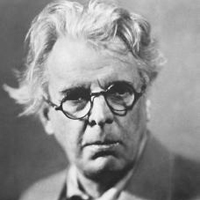Byzantium by William Butler Yeats: Summary and Poem
Byzantium is a description of the city bearing that name, but it is also a symbol of paradise as well as Purgatory. Byzantium usually discussed as a companion piece to Sailing to Byzantium written four years later, takes up the actual process by which the artist creates his images and, in a bold stroke by Yeats compares the creative process to the soul’s journey after death.

William B. Yeats (1865-1939)
Summary of Stanza I
The ordinary gross objects of the work-a-day world go into the background. The drunken soldiers of the emperor are now asleep. The voices of the night become faint; the night -walker's song comes to an end, after the sound of the gong of the great Cathedral (St. Sophia). A star studded or moonlit dome of the sky scorns all that man is and all his complexities and the passion and the dross of human life (the violence and decay and impermanence of man's life).
Stanza I
The unpurged images of day recede;
The Emperor's drunken soldiery are abed;
Night resonance recedes, night walkers' song
After great cathedral gong;
A starlit or a moonlit dome disdains
All that man is,
All mere complexities,
The fury and the mire of human veins.
Summary of Stanza II
Before the poet appears a vision-perhaps a man or shade or a visible ghost of an invisible spirit, a purified spirit which has unwound the coffin cloth and then has cast away its impurities and become a purified spirit. It is a lifeless image as also an immortal being and the poet calls it death in-life and life-in-death.
Stanza II
Before me floats an image, man or shade,
Shade more than man, more image than a shade;
For Hades' bobbin bound in mummy-cloth
May unwind the winding path;
A mouth that has no moisture and no breath
Breathless mouths may summon;
I hail the superhuman;
I call it death-in-life and life-in-death.
Summary of Stanza III
The poet sees a sort of miracle. Is it a golden bird or is it something else or is it an unusual bird on starlit golden bough? It can crow like the cocks of hell, or scorn others birds of petals and all the changes which flesh is heir to.
Stanza III
Miracle, bird or golden handiwork,
More miracle than bird or handiwork,
Planted on the star-lit golden bough,
Can like the cocks of Hades crow,
Or, by the moon embittered, scorn aloud
In glory of changeless metal
Common bird or petal
And all complexities of mire or blood.
Summary of Stanza IV
At midnight on the Emperor's pavement appears a fire which is not fed by fuel or started by striking a piece of iron against a flint stone. No storm can disturb these flames which are begotten of blood (according to medieval belief) or are self-generating. Here the spirits are purified of all their passions in the flames. There the purgatorial dance of spirit begins and ends in a sort of peace and joy. The spirits thus purified gain eternal peace.
Stanza IV
At midnight on the Emperor's pavement flit
Flames that no faggot feeds, nor steel has lit,
Nor storm disturbs, flames begotten of flame,
Where blood-begotten spirits come
And all complexities of fury leave,
Dying into a dance,
An agony of trance,
An agony of flame that cannot singe a sleeve.
Summary of Stanza V
Sprits sit astride on the dolphins with their mire and blood and reach the beach of Byzantium. The blacksmiths of the emperor impose order on these spirits. The marbles of the dancing floor break little furies of complexity, and those images that beget fresh images and also the dolphin torn, that gong tormented sea.
Stanza V
Astraddle on the dolphin's mire and blood,
Spirit after Spirit! The smithies break the flood.
The golden smithies of the Emperor!
Marbles of the dancing floor
Break bitter furies of complexity,
Those images that yet
Fresh images beget,
That dolphin-torn, that gong-tormented sea.
Cite this Page!
Sharma, K.N. "Byzantium by William Butler Yeats: Summary and Poem." BachelorandMaster, 23 Nov. 2013, bachelorandmaster.com/britishandamericanpoetry/byzantium.html.
Related Topics
Sailing to Byzantium: Analysis
The Theme of Immortality in Byzantium Poems
The Scholars: Critical Analysis
A Prayer for My Daughter: Analysis
Among School Children: Analysis
Crazy Jane Talks with the Bishop
The Lamentation of the Old Pensioner
He Wishes for the Clothes of Heaven
An Irish Airman Foresees his Death
When You Are Old: Summary and Analysis
William Butler Yeats as a Symbolist
Truth of Human Life in Yeats's Poetry
Yeats and the Romantic Tradition
The Salient Features of Yeats's Poetry
Biography of William Butler Yeats
 |
bachelorandmaster.com |